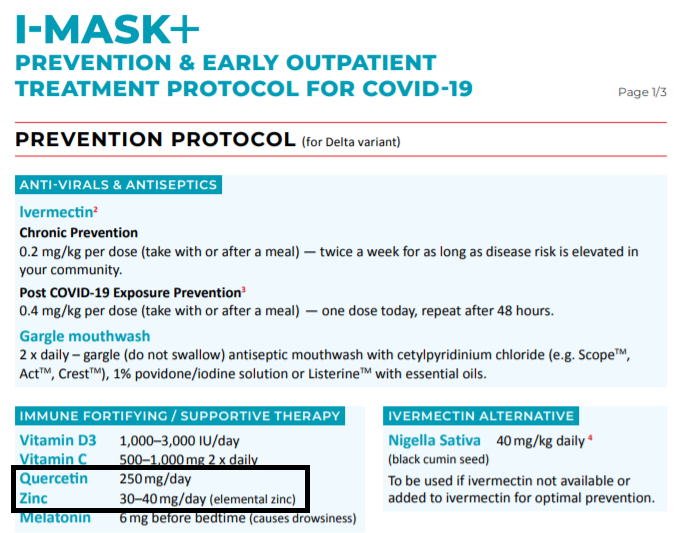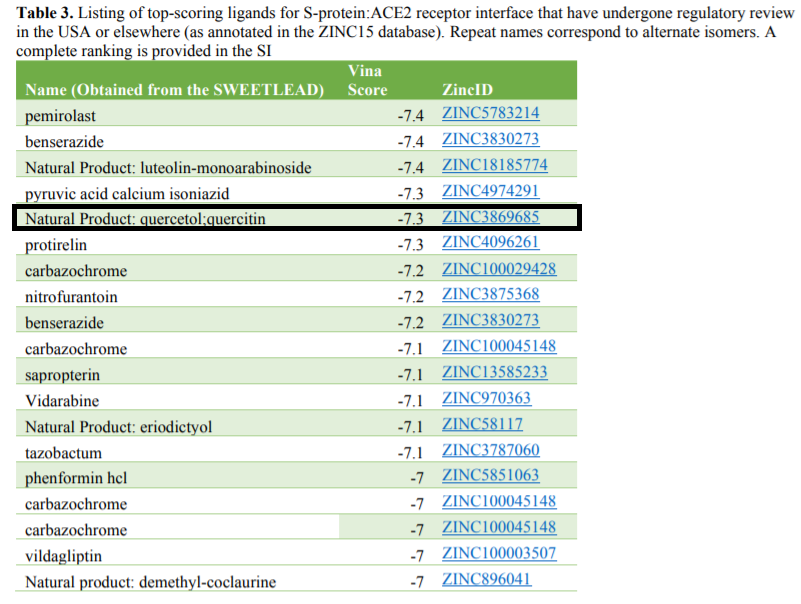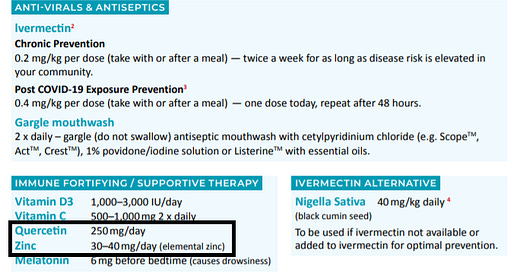Quercetin: An Over-The-Counter Hydroxychloroquine, or Something More?
Part II: Targeting SARS-COV2
Quercetin against SARS-COV2
When it comes to Quercetin acting against SARS-COV2 specifically, we will see some overlaps with Hydroxychloroquine, so know that some things may be reiterated here. I won’t go into more detail about Quercetin as a Zinc Ionophore since there’s isn’t too much evidence, so we’ll dive into other topics.
Advocates of Hydroxychloroquine use, such as Dr. Zelenko, have advocated for the use of Quercetin/Zinc for at-home prophylaxis usage in order to target SARS-COV2.
In fact, it is part of the Front Line Critical Covid-19 Care Alliance (FLCCC) protocol for prophylactic use and for first line of therapy.

In order to justify strong advocacy for this compound’s use, we should examine whether there is good evidence of Quercetin against SARS-COV2 infection.
ACEII/Spike Protein Docking Inhibition
Through computational modeling there seems to be some evidence that Quercetin may bind directly to the ACEII/Spike protein interface. By binding to either the spike protein or the ACEII receptor, a compound will inhibit the binding of the two structures together. Inhibition in this fashion would prevent viral attachment and inhibit viral entry into host cells.
This can be seen in a paper by Smith et. al. 2020, in which supercomputer calculations indicated strong binding of Quercetin to vital Spike/ACEII interfaces.

Remember that this study looked at modeling and calculations in order to determine good interface candidates. Although this study doesn’t show actual actions against SARS-COV2’s spike protein, it suggests a possible effect that more studies should look into. Fortunately, there is another study that indicates in vitro binding of Quercetin to the ACEII receptor.
In a study conducted by Liu et. al. 2020, higher concentrations of Quercetin were related with greater inhibition of ACEII receptor activity.

As the researchers suggested, chronic ACEII inhibition may not be favorable as the receptor is vital to many cellular functions. Nonetheless, the findings from this study points to the idea that Quercetin may inhibit ACEII activity, which would help to prevent SARS-COV2 viral binding to the ACEII receptor and thus prevent greater viral infection.
This is also indicated in a molecular docking study conducted by Tao et. al. 2020, in which researchers indicated strong binding of Quercetin specifically to the ACEII receptor due to the hydrogen bonding capabilities of the flavanoid (emphasis mine):
Meanwhile, quercetin (MOL000098) showed strong association with ACE2. The small molecule quercetin showed a compact binding pattern with ACE2 protein active pocket. Quercetin formed four hydrogen bonds with the amino acid residues Lys745, Tyr613, His493, and Asp609, making quercetin and ACE2 form a stable complex (Figure 5). The binding energies of the various compounds are shown in Table 4.

Although another computer modeled study, the evidence here suggests that Quercetin’s binding activity to ACEII is comparable to other standard of care drugs used to treat SARS-COV2 (eg. Remdesivir, Lopinavir, Ritonavir). Remdesivir is used predominately to inhibit viral replication, while Lopinavir is intended to target the virus’ main protease. Granted, the researchers also examined possible binding to SARS-COV2’s main protease, showing that Querceting also has comparable binding to other SARS-COV2 drugs as well. If the intent is to inhibit ACEII activity, it seems that Quercetin would serve as a very safe, comparable, over-the-counter alternative to other standard care drugs.
Taken all together, there’s some evidence that suggests that Quercetin may serve as a good candidate to target the ACEII receptor and prevent viral binding.
Main Protease (3CLPro) Inhibition
Most of the studies that examined Quercetin’s activity seems to point to the flavanoid’s inhibition of SARS-COV2’s main protease.
One study, conducted by Abian et. al. 2020, showed in vitro activity of Quercetin against the main protease:

Once again, in vitro studies need to be followed by in vivo studies that show efficacies in animal and human trials. Also, the high concentrations of Quercetin may not be possible in animals or humans. Nonetheless, this indicates a possible line of evidence to suggest Quercetin’s use.
As elaborated by the researchers, the binding of Quercetin seems to occur within the protease’s active site (emphasis mine):
Interactions with a number of protein residues contribute to bind quercetin into the 3CLpro binding site. The key residue is Met165, which can form both hydrogen bonds and hydrophobic interactions with quercetin. Additional hydrogen bonds can be formed with the two residues Ser144 and Asn142. Energetic contributions are also due to supplementary hydrophobic interactions with Met49, Phe140 and Leu141, and to electrostatic interaction formed with the polar residue His164 and the charged residue Glu166.
However, there is some evidence via Verma et. al. 2021 that Quercetin may act as an allosteric inhibitor of the main protease.
Up to this point most protease inhibitors have been competitive inhibitors, which bind to the active site of the enzyme. This is where enzymatic reactions occur and provide the enzyme with its main functionality. In the case of an allosteric inhibitor, the compound binds to a separate site on the enzyme. By doing so, the enzyme undergoes a conformational change which changes the structure of the active site of the enzyme. Thus, the enzyme is rendered nonfunctional even though the compound in question does not directly target the vital portion of the enzyme.
This serves a critical role. As the name implies, competitive inhibitors need to “compete” with the compound that usually is involved with the enzymatic reaction. In the case of the main protease, Quercetin needs to compete with the usual proteins that are chopped up by the protease, and usually overcomes the competition with higher concentrations of Quercetin. Because allosteric inhibitors bind at a separate enzyme site, their activity is not concentration dependent, meaning even low doses of an allosteric inhibitor can have huge effects on an enzyme’s activity. This is extremely important when the toxicity of a drug needs to be taken into consideration, as higher concentrations of a drug may be more dangerous than therapeutic.
Although another computer modeled study, the researchers (Verma et. al. 2021) noted that Quercetin may bind in an area separate to the protease’s active site (emphasis mine):
In our analysis, we revealed quercetin as an effective allosteric inhibitor which can bind to the Mpro even when the active site is occupied by the substrate and will not be affected by any change in substrate concentration (Ramsay and Tipton 2017; Robinson 2015). Although very few studies have recently reported effective allosteric inhibitors against SARS-CoV-2 Mpro, a topological analysis of the Mpro revealed its very high sensitivity against any perturbation which it encounters and displayed excessively high tendency of the enzyme in transmitting it across the structure (Estradaa 2020; Doshi et al. 2016; Negre et al. 2018). These evidences can provide immense support to our present analysis of allosteric inhibition of Mpro by quercetin where binding of the compound in consideration, at a different site modulates the active site to reduce its affinity for the substrate. Hence, all the above results and facts prove that quercetin by binding at an allosteric site in SARS-CoV-2 Mpro can effectively inhibit the binding and thus the catalytic cleavage of substrate polypeptides 1a and 1ab. Such exclusive allosteric inhibition by a natural flavonol can massively hamper the replication of SARS-CoV-2 virus and can be developed into an exceedingly efficient and safe treatment against the current pandemic of COVID-19.
So we can see that there’s plenty of benefits to Quercetin intake, and not just against COVID-19. However, we’ll need to examine some clinical studies to see if there is any evidence of effectiveness in humans.
Tomorrow I’ll release Part III looking at Clinical Trials and prior studies on Quercetin, so be on the lookout for that!
Thank you for reading my newsletter. If you enjoy my articles please consider becoming a free subscriber in order to receive notifications.
And share with others who may find these newsletters interesting.
Also, please consider becoming a paid member. The research and work put into these articles takes many hours and being a paid subscriber allows me to continue to do this full time.




Thanks for this. Preventative and early treatment works, but until it's an Rx the medical community is not interested.
Flccc has done great work in this area. I have been on their protocol all year and, in spite of close exposures, have not gotten ill when others in the group did.
I'd hesitate to use the FLCCC as a source for legitimizing the use of ivermectin in clinical practice. First, the dose they recommend is much different than the "safe" evaluated dose for parasitic infections that was approved by the FDA log ago; thus the potential physiologic effects are not known and the relative safety of the drug given at their recommendation cannot be extrapolated from the existing data. Additionally, I would hesitate to take any sort of guidance from a group for whom "membership" requires that you support their recommendations (their "join us" form asks that the applicant check off all the drugs that they use in practice, which is basically a list of the vitamins/drugs the FLCCC recommends). Does ivermectin work theoretically? Sure, there's evidence. Does it work in actual clinical settings? The verdict is still not clear, mostly being anecdotal or small scale. Given the lack of large scale controlled clinical trials (and lack of dose-escalation studies to even define a working range), it seems premature to advocate for their inclusion in a treatment regimen - especially for prophylaxis.